Analyzing Unilever and Ikea's Consumer Strategies: A Case Study
VerifiedAdded on 2021/05/31
|10
|3133
|669
Case Study
AI Summary
This case study report analyzes the marketing strategies of Unilever and Ikea, examining how these companies connect with consumers and adapt to cultural influences. The report delves into Unilever's application of consumer psychology, particularly focusing on the psychological core, and evaluates the effectiveness of the Dove Campaign for Real Beauty. It also explores Unilever's decisions to link its brands with healthy and sustainable behaviors. The second part of the case study focuses on Ikea, analyzing the Manland experiment, classifying Ikea's products in terms of consumer behavior (conspicuous, voluntary simplicity, and compensatory consumption), and assessing the impact of controversial advertising on the retailer's image. The report provides detailed answers to specific questions related to each case, supported by academic references.

Case Study Report
Paraphrase This Document
Need a fresh take? Get an instant paraphrase of this document with our AI Paraphraser
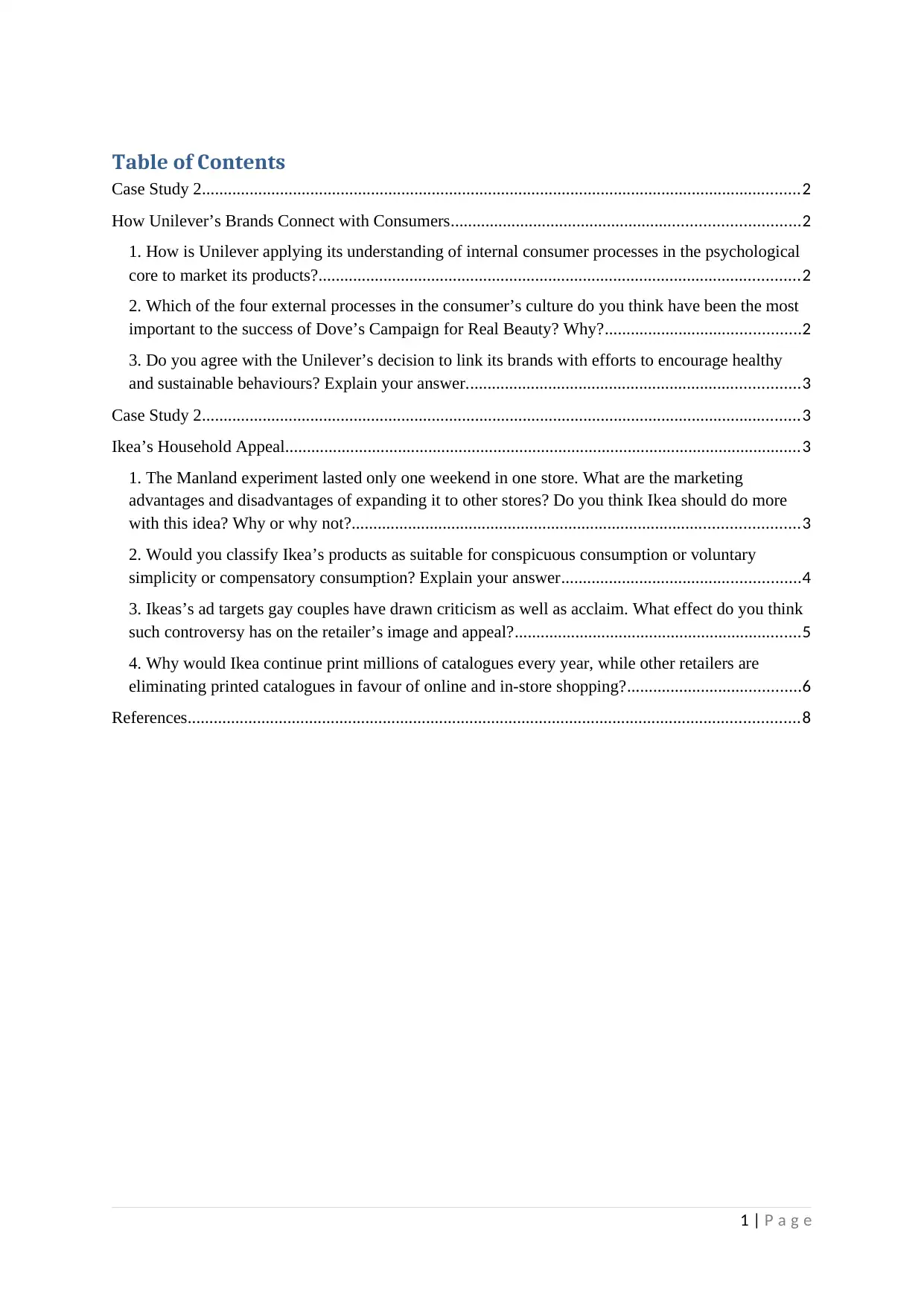
Table of Contents
Case Study 2..........................................................................................................................................2
How Unilever’s Brands Connect with Consumers................................................................................2
1. How is Unilever applying its understanding of internal consumer processes in the psychological
core to market its products?...............................................................................................................2
2. Which of the four external processes in the consumer’s culture do you think have been the most
important to the success of Dove’s Campaign for Real Beauty? Why?.............................................2
3. Do you agree with the Unilever’s decision to link its brands with efforts to encourage healthy
and sustainable behaviours? Explain your answer.............................................................................3
Case Study 2..........................................................................................................................................3
Ikea’s Household Appeal.......................................................................................................................3
1. The Manland experiment lasted only one weekend in one store. What are the marketing
advantages and disadvantages of expanding it to other stores? Do you think Ikea should do more
with this idea? Why or why not?.......................................................................................................3
2. Would you classify Ikea’s products as suitable for conspicuous consumption or voluntary
simplicity or compensatory consumption? Explain your answer.......................................................4
3. Ikeas’s ad targets gay couples have drawn criticism as well as acclaim. What effect do you think
such controversy has on the retailer’s image and appeal?..................................................................5
4. Why would Ikea continue print millions of catalogues every year, while other retailers are
eliminating printed catalogues in favour of online and in-store shopping?........................................6
References.............................................................................................................................................8
1 | P a g e
Case Study 2..........................................................................................................................................2
How Unilever’s Brands Connect with Consumers................................................................................2
1. How is Unilever applying its understanding of internal consumer processes in the psychological
core to market its products?...............................................................................................................2
2. Which of the four external processes in the consumer’s culture do you think have been the most
important to the success of Dove’s Campaign for Real Beauty? Why?.............................................2
3. Do you agree with the Unilever’s decision to link its brands with efforts to encourage healthy
and sustainable behaviours? Explain your answer.............................................................................3
Case Study 2..........................................................................................................................................3
Ikea’s Household Appeal.......................................................................................................................3
1. The Manland experiment lasted only one weekend in one store. What are the marketing
advantages and disadvantages of expanding it to other stores? Do you think Ikea should do more
with this idea? Why or why not?.......................................................................................................3
2. Would you classify Ikea’s products as suitable for conspicuous consumption or voluntary
simplicity or compensatory consumption? Explain your answer.......................................................4
3. Ikeas’s ad targets gay couples have drawn criticism as well as acclaim. What effect do you think
such controversy has on the retailer’s image and appeal?..................................................................5
4. Why would Ikea continue print millions of catalogues every year, while other retailers are
eliminating printed catalogues in favour of online and in-store shopping?........................................6
References.............................................................................................................................................8
1 | P a g e
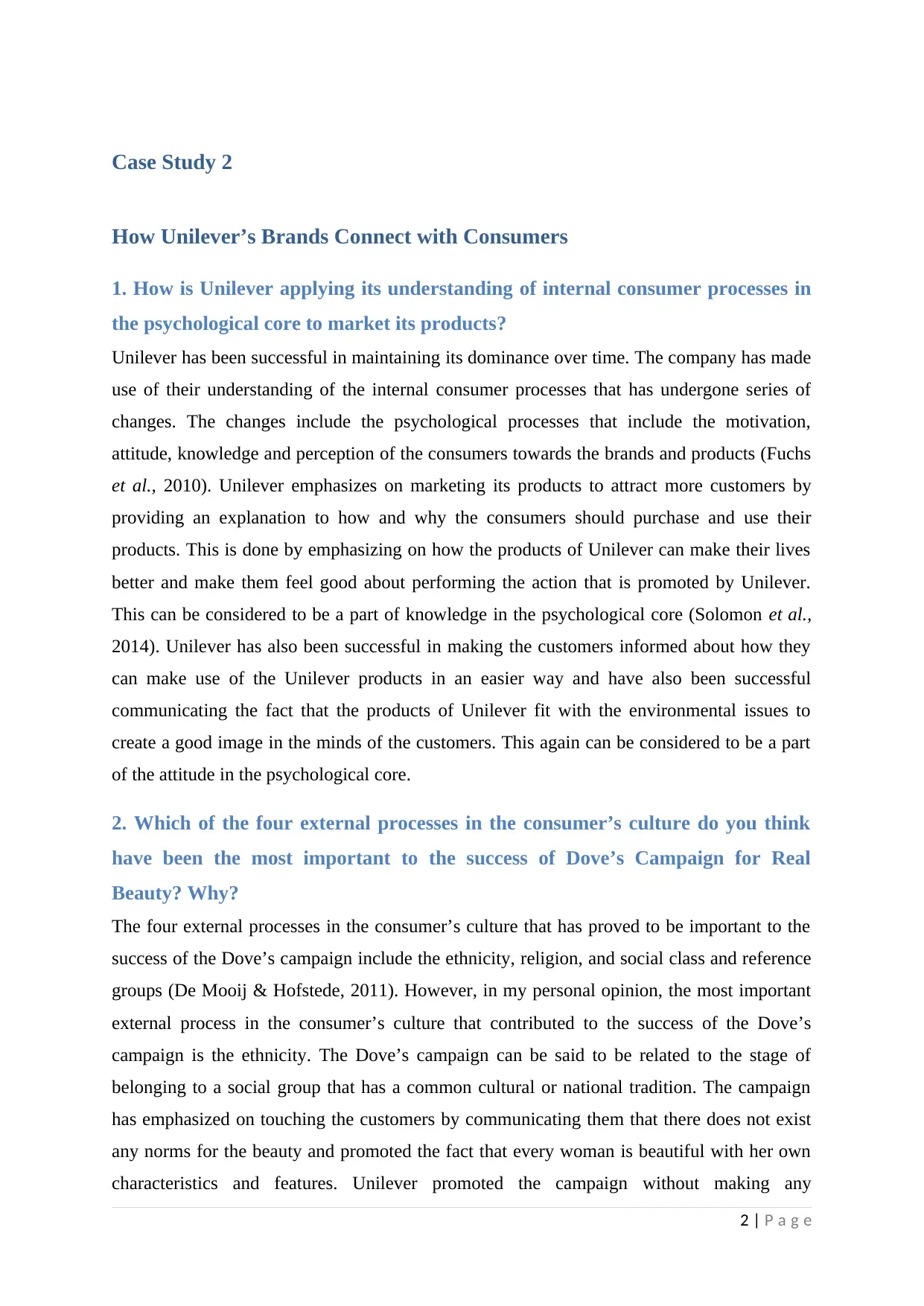
Case Study 2
How Unilever’s Brands Connect with Consumers
1. How is Unilever applying its understanding of internal consumer processes in
the psychological core to market its products?
Unilever has been successful in maintaining its dominance over time. The company has made
use of their understanding of the internal consumer processes that has undergone series of
changes. The changes include the psychological processes that include the motivation,
attitude, knowledge and perception of the consumers towards the brands and products (Fuchs
et al., 2010). Unilever emphasizes on marketing its products to attract more customers by
providing an explanation to how and why the consumers should purchase and use their
products. This is done by emphasizing on how the products of Unilever can make their lives
better and make them feel good about performing the action that is promoted by Unilever.
This can be considered to be a part of knowledge in the psychological core (Solomon et al.,
2014). Unilever has also been successful in making the customers informed about how they
can make use of the Unilever products in an easier way and have also been successful
communicating the fact that the products of Unilever fit with the environmental issues to
create a good image in the minds of the customers. This again can be considered to be a part
of the attitude in the psychological core.
2. Which of the four external processes in the consumer’s culture do you think
have been the most important to the success of Dove’s Campaign for Real
Beauty? Why?
The four external processes in the consumer’s culture that has proved to be important to the
success of the Dove’s campaign include the ethnicity, religion, and social class and reference
groups (De Mooij & Hofstede, 2011). However, in my personal opinion, the most important
external process in the consumer’s culture that contributed to the success of the Dove’s
campaign is the ethnicity. The Dove’s campaign can be said to be related to the stage of
belonging to a social group that has a common cultural or national tradition. The campaign
has emphasized on touching the customers by communicating them that there does not exist
any norms for the beauty and promoted the fact that every woman is beautiful with her own
characteristics and features. Unilever promoted the campaign without making any
2 | P a g e
How Unilever’s Brands Connect with Consumers
1. How is Unilever applying its understanding of internal consumer processes in
the psychological core to market its products?
Unilever has been successful in maintaining its dominance over time. The company has made
use of their understanding of the internal consumer processes that has undergone series of
changes. The changes include the psychological processes that include the motivation,
attitude, knowledge and perception of the consumers towards the brands and products (Fuchs
et al., 2010). Unilever emphasizes on marketing its products to attract more customers by
providing an explanation to how and why the consumers should purchase and use their
products. This is done by emphasizing on how the products of Unilever can make their lives
better and make them feel good about performing the action that is promoted by Unilever.
This can be considered to be a part of knowledge in the psychological core (Solomon et al.,
2014). Unilever has also been successful in making the customers informed about how they
can make use of the Unilever products in an easier way and have also been successful
communicating the fact that the products of Unilever fit with the environmental issues to
create a good image in the minds of the customers. This again can be considered to be a part
of the attitude in the psychological core.
2. Which of the four external processes in the consumer’s culture do you think
have been the most important to the success of Dove’s Campaign for Real
Beauty? Why?
The four external processes in the consumer’s culture that has proved to be important to the
success of the Dove’s campaign include the ethnicity, religion, and social class and reference
groups (De Mooij & Hofstede, 2011). However, in my personal opinion, the most important
external process in the consumer’s culture that contributed to the success of the Dove’s
campaign is the ethnicity. The Dove’s campaign can be said to be related to the stage of
belonging to a social group that has a common cultural or national tradition. The campaign
has emphasized on touching the customers by communicating them that there does not exist
any norms for the beauty and promoted the fact that every woman is beautiful with her own
characteristics and features. Unilever promoted the campaign without making any
2 | P a g e
⊘ This is a preview!⊘
Do you want full access?
Subscribe today to unlock all pages.

Trusted by 1+ million students worldwide
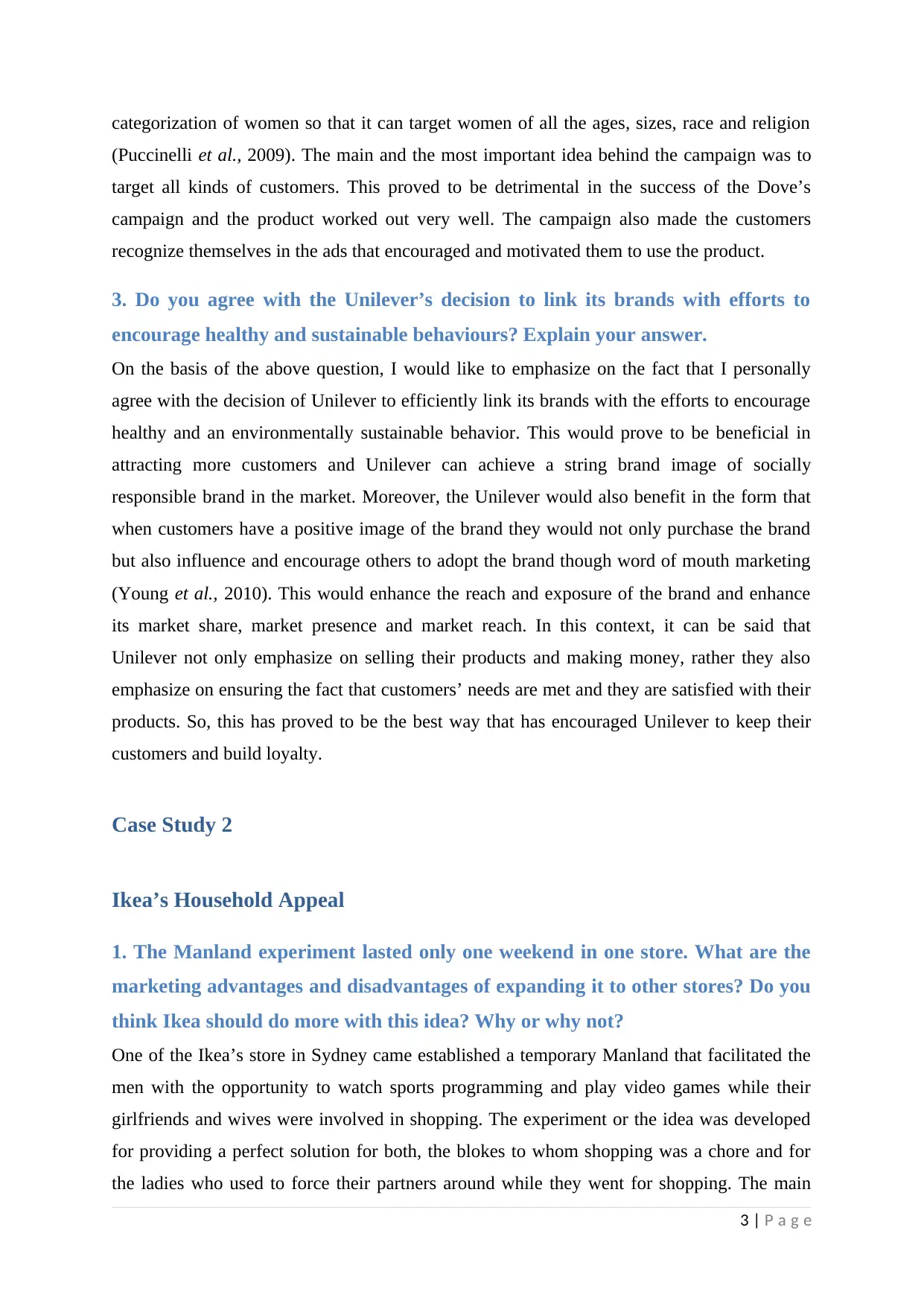
categorization of women so that it can target women of all the ages, sizes, race and religion
(Puccinelli et al., 2009). The main and the most important idea behind the campaign was to
target all kinds of customers. This proved to be detrimental in the success of the Dove’s
campaign and the product worked out very well. The campaign also made the customers
recognize themselves in the ads that encouraged and motivated them to use the product.
3. Do you agree with the Unilever’s decision to link its brands with efforts to
encourage healthy and sustainable behaviours? Explain your answer.
On the basis of the above question, I would like to emphasize on the fact that I personally
agree with the decision of Unilever to efficiently link its brands with the efforts to encourage
healthy and an environmentally sustainable behavior. This would prove to be beneficial in
attracting more customers and Unilever can achieve a string brand image of socially
responsible brand in the market. Moreover, the Unilever would also benefit in the form that
when customers have a positive image of the brand they would not only purchase the brand
but also influence and encourage others to adopt the brand though word of mouth marketing
(Young et al., 2010). This would enhance the reach and exposure of the brand and enhance
its market share, market presence and market reach. In this context, it can be said that
Unilever not only emphasize on selling their products and making money, rather they also
emphasize on ensuring the fact that customers’ needs are met and they are satisfied with their
products. So, this has proved to be the best way that has encouraged Unilever to keep their
customers and build loyalty.
Case Study 2
Ikea’s Household Appeal
1. The Manland experiment lasted only one weekend in one store. What are the
marketing advantages and disadvantages of expanding it to other stores? Do you
think Ikea should do more with this idea? Why or why not?
One of the Ikea’s store in Sydney came established a temporary Manland that facilitated the
men with the opportunity to watch sports programming and play video games while their
girlfriends and wives were involved in shopping. The experiment or the idea was developed
for providing a perfect solution for both, the blokes to whom shopping was a chore and for
the ladies who used to force their partners around while they went for shopping. The main
3 | P a g e
(Puccinelli et al., 2009). The main and the most important idea behind the campaign was to
target all kinds of customers. This proved to be detrimental in the success of the Dove’s
campaign and the product worked out very well. The campaign also made the customers
recognize themselves in the ads that encouraged and motivated them to use the product.
3. Do you agree with the Unilever’s decision to link its brands with efforts to
encourage healthy and sustainable behaviours? Explain your answer.
On the basis of the above question, I would like to emphasize on the fact that I personally
agree with the decision of Unilever to efficiently link its brands with the efforts to encourage
healthy and an environmentally sustainable behavior. This would prove to be beneficial in
attracting more customers and Unilever can achieve a string brand image of socially
responsible brand in the market. Moreover, the Unilever would also benefit in the form that
when customers have a positive image of the brand they would not only purchase the brand
but also influence and encourage others to adopt the brand though word of mouth marketing
(Young et al., 2010). This would enhance the reach and exposure of the brand and enhance
its market share, market presence and market reach. In this context, it can be said that
Unilever not only emphasize on selling their products and making money, rather they also
emphasize on ensuring the fact that customers’ needs are met and they are satisfied with their
products. So, this has proved to be the best way that has encouraged Unilever to keep their
customers and build loyalty.
Case Study 2
Ikea’s Household Appeal
1. The Manland experiment lasted only one weekend in one store. What are the
marketing advantages and disadvantages of expanding it to other stores? Do you
think Ikea should do more with this idea? Why or why not?
One of the Ikea’s store in Sydney came established a temporary Manland that facilitated the
men with the opportunity to watch sports programming and play video games while their
girlfriends and wives were involved in shopping. The experiment or the idea was developed
for providing a perfect solution for both, the blokes to whom shopping was a chore and for
the ladies who used to force their partners around while they went for shopping. The main
3 | P a g e
Paraphrase This Document
Need a fresh take? Get an instant paraphrase of this document with our AI Paraphraser
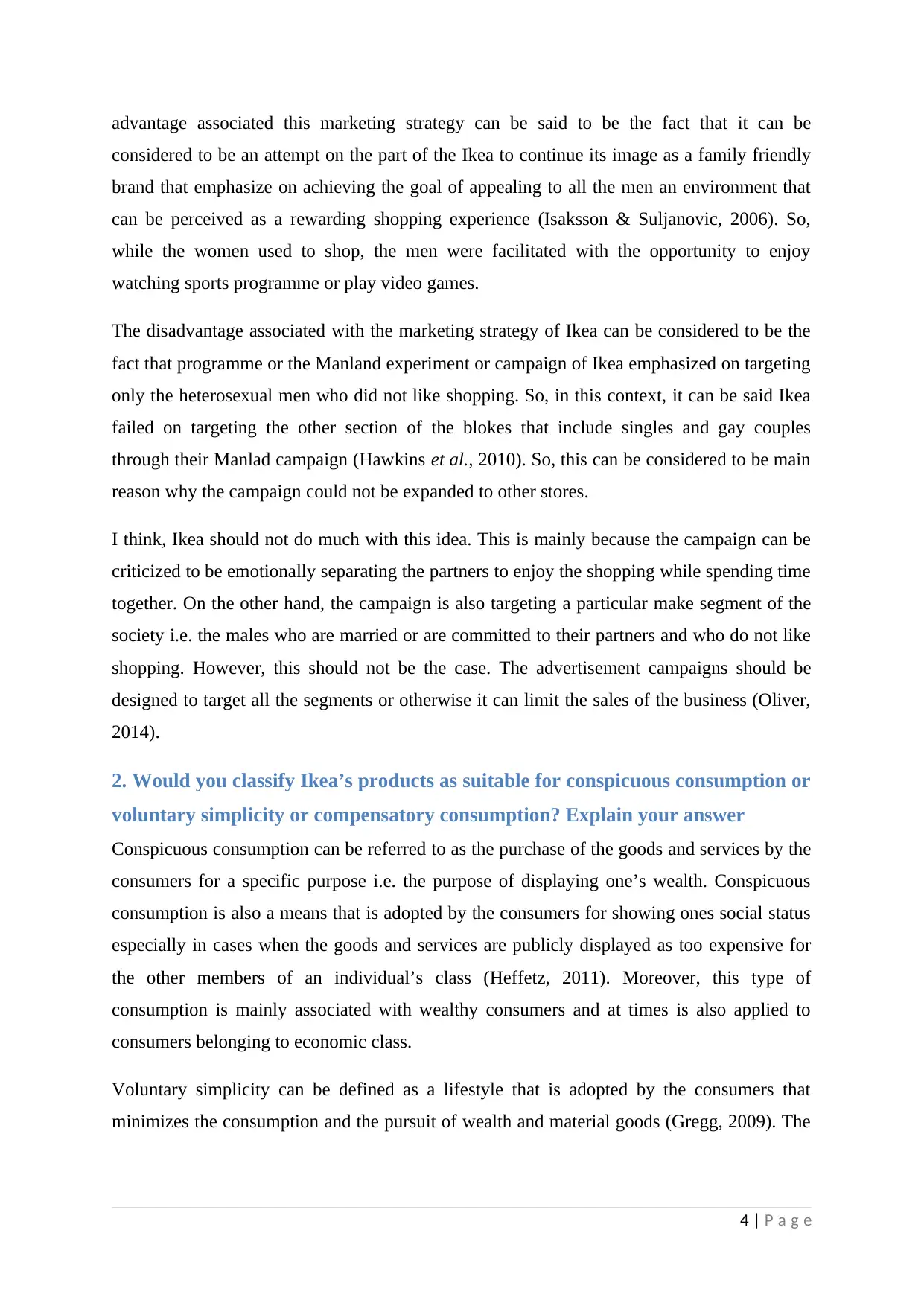
advantage associated this marketing strategy can be said to be the fact that it can be
considered to be an attempt on the part of the Ikea to continue its image as a family friendly
brand that emphasize on achieving the goal of appealing to all the men an environment that
can be perceived as a rewarding shopping experience (Isaksson & Suljanovic, 2006). So,
while the women used to shop, the men were facilitated with the opportunity to enjoy
watching sports programme or play video games.
The disadvantage associated with the marketing strategy of Ikea can be considered to be the
fact that programme or the Manland experiment or campaign of Ikea emphasized on targeting
only the heterosexual men who did not like shopping. So, in this context, it can be said Ikea
failed on targeting the other section of the blokes that include singles and gay couples
through their Manlad campaign (Hawkins et al., 2010). So, this can be considered to be main
reason why the campaign could not be expanded to other stores.
I think, Ikea should not do much with this idea. This is mainly because the campaign can be
criticized to be emotionally separating the partners to enjoy the shopping while spending time
together. On the other hand, the campaign is also targeting a particular make segment of the
society i.e. the males who are married or are committed to their partners and who do not like
shopping. However, this should not be the case. The advertisement campaigns should be
designed to target all the segments or otherwise it can limit the sales of the business (Oliver,
2014).
2. Would you classify Ikea’s products as suitable for conspicuous consumption or
voluntary simplicity or compensatory consumption? Explain your answer
Conspicuous consumption can be referred to as the purchase of the goods and services by the
consumers for a specific purpose i.e. the purpose of displaying one’s wealth. Conspicuous
consumption is also a means that is adopted by the consumers for showing ones social status
especially in cases when the goods and services are publicly displayed as too expensive for
the other members of an individual’s class (Heffetz, 2011). Moreover, this type of
consumption is mainly associated with wealthy consumers and at times is also applied to
consumers belonging to economic class.
Voluntary simplicity can be defined as a lifestyle that is adopted by the consumers that
minimizes the consumption and the pursuit of wealth and material goods (Gregg, 2009). The
4 | P a g e
considered to be an attempt on the part of the Ikea to continue its image as a family friendly
brand that emphasize on achieving the goal of appealing to all the men an environment that
can be perceived as a rewarding shopping experience (Isaksson & Suljanovic, 2006). So,
while the women used to shop, the men were facilitated with the opportunity to enjoy
watching sports programme or play video games.
The disadvantage associated with the marketing strategy of Ikea can be considered to be the
fact that programme or the Manland experiment or campaign of Ikea emphasized on targeting
only the heterosexual men who did not like shopping. So, in this context, it can be said Ikea
failed on targeting the other section of the blokes that include singles and gay couples
through their Manlad campaign (Hawkins et al., 2010). So, this can be considered to be main
reason why the campaign could not be expanded to other stores.
I think, Ikea should not do much with this idea. This is mainly because the campaign can be
criticized to be emotionally separating the partners to enjoy the shopping while spending time
together. On the other hand, the campaign is also targeting a particular make segment of the
society i.e. the males who are married or are committed to their partners and who do not like
shopping. However, this should not be the case. The advertisement campaigns should be
designed to target all the segments or otherwise it can limit the sales of the business (Oliver,
2014).
2. Would you classify Ikea’s products as suitable for conspicuous consumption or
voluntary simplicity or compensatory consumption? Explain your answer
Conspicuous consumption can be referred to as the purchase of the goods and services by the
consumers for a specific purpose i.e. the purpose of displaying one’s wealth. Conspicuous
consumption is also a means that is adopted by the consumers for showing ones social status
especially in cases when the goods and services are publicly displayed as too expensive for
the other members of an individual’s class (Heffetz, 2011). Moreover, this type of
consumption is mainly associated with wealthy consumers and at times is also applied to
consumers belonging to economic class.
Voluntary simplicity can be defined as a lifestyle that is adopted by the consumers that
minimizes the consumption and the pursuit of wealth and material goods (Gregg, 2009). The
4 | P a g e
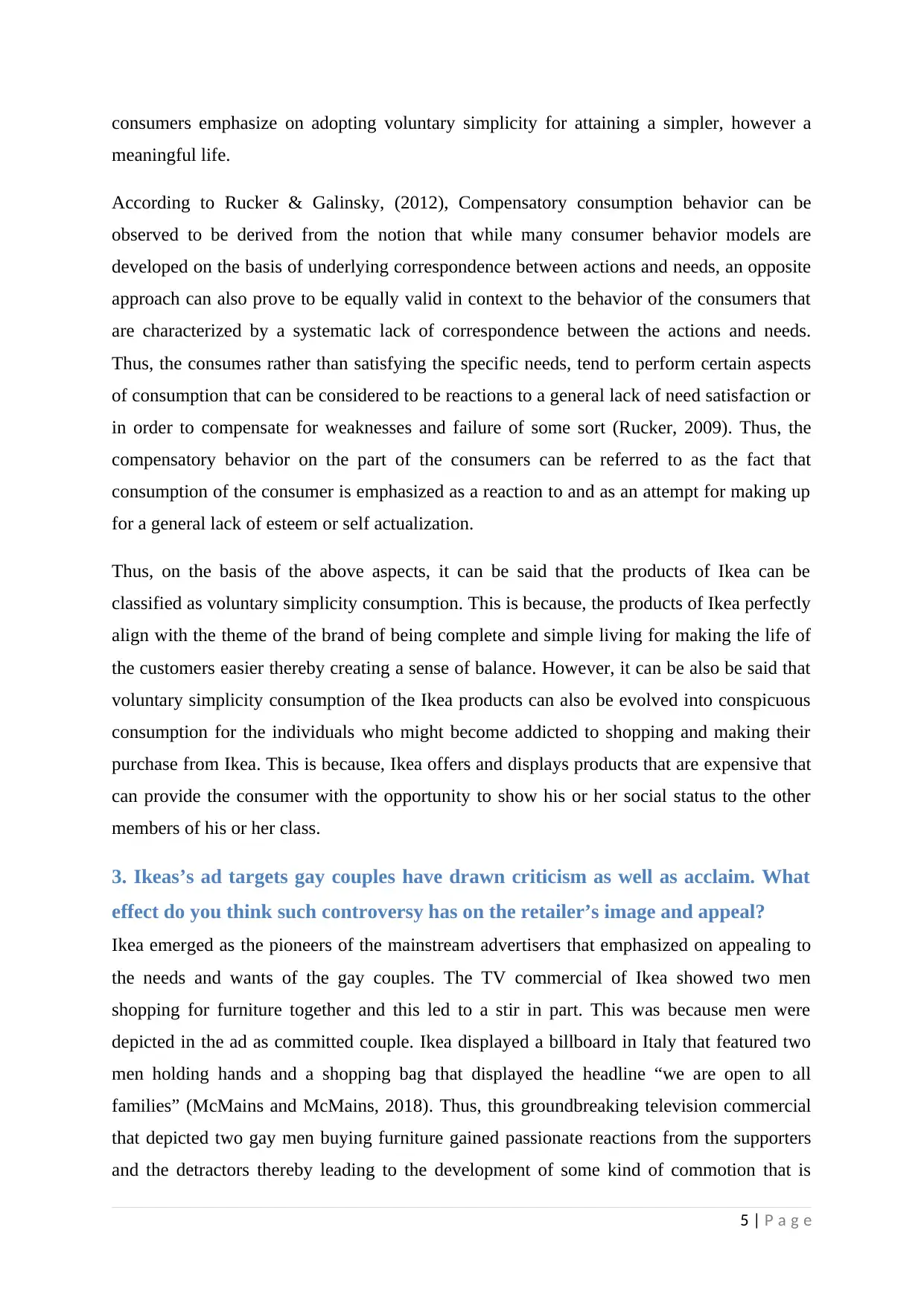
consumers emphasize on adopting voluntary simplicity for attaining a simpler, however a
meaningful life.
According to Rucker & Galinsky, (2012), Compensatory consumption behavior can be
observed to be derived from the notion that while many consumer behavior models are
developed on the basis of underlying correspondence between actions and needs, an opposite
approach can also prove to be equally valid in context to the behavior of the consumers that
are characterized by a systematic lack of correspondence between the actions and needs.
Thus, the consumes rather than satisfying the specific needs, tend to perform certain aspects
of consumption that can be considered to be reactions to a general lack of need satisfaction or
in order to compensate for weaknesses and failure of some sort (Rucker, 2009). Thus, the
compensatory behavior on the part of the consumers can be referred to as the fact that
consumption of the consumer is emphasized as a reaction to and as an attempt for making up
for a general lack of esteem or self actualization.
Thus, on the basis of the above aspects, it can be said that the products of Ikea can be
classified as voluntary simplicity consumption. This is because, the products of Ikea perfectly
align with the theme of the brand of being complete and simple living for making the life of
the customers easier thereby creating a sense of balance. However, it can be also be said that
voluntary simplicity consumption of the Ikea products can also be evolved into conspicuous
consumption for the individuals who might become addicted to shopping and making their
purchase from Ikea. This is because, Ikea offers and displays products that are expensive that
can provide the consumer with the opportunity to show his or her social status to the other
members of his or her class.
3. Ikeas’s ad targets gay couples have drawn criticism as well as acclaim. What
effect do you think such controversy has on the retailer’s image and appeal?
Ikea emerged as the pioneers of the mainstream advertisers that emphasized on appealing to
the needs and wants of the gay couples. The TV commercial of Ikea showed two men
shopping for furniture together and this led to a stir in part. This was because men were
depicted in the ad as committed couple. Ikea displayed a billboard in Italy that featured two
men holding hands and a shopping bag that displayed the headline “we are open to all
families” (McMains and McMains, 2018). Thus, this groundbreaking television commercial
that depicted two gay men buying furniture gained passionate reactions from the supporters
and the detractors thereby leading to the development of some kind of commotion that is
5 | P a g e
meaningful life.
According to Rucker & Galinsky, (2012), Compensatory consumption behavior can be
observed to be derived from the notion that while many consumer behavior models are
developed on the basis of underlying correspondence between actions and needs, an opposite
approach can also prove to be equally valid in context to the behavior of the consumers that
are characterized by a systematic lack of correspondence between the actions and needs.
Thus, the consumes rather than satisfying the specific needs, tend to perform certain aspects
of consumption that can be considered to be reactions to a general lack of need satisfaction or
in order to compensate for weaknesses and failure of some sort (Rucker, 2009). Thus, the
compensatory behavior on the part of the consumers can be referred to as the fact that
consumption of the consumer is emphasized as a reaction to and as an attempt for making up
for a general lack of esteem or self actualization.
Thus, on the basis of the above aspects, it can be said that the products of Ikea can be
classified as voluntary simplicity consumption. This is because, the products of Ikea perfectly
align with the theme of the brand of being complete and simple living for making the life of
the customers easier thereby creating a sense of balance. However, it can be also be said that
voluntary simplicity consumption of the Ikea products can also be evolved into conspicuous
consumption for the individuals who might become addicted to shopping and making their
purchase from Ikea. This is because, Ikea offers and displays products that are expensive that
can provide the consumer with the opportunity to show his or her social status to the other
members of his or her class.
3. Ikeas’s ad targets gay couples have drawn criticism as well as acclaim. What
effect do you think such controversy has on the retailer’s image and appeal?
Ikea emerged as the pioneers of the mainstream advertisers that emphasized on appealing to
the needs and wants of the gay couples. The TV commercial of Ikea showed two men
shopping for furniture together and this led to a stir in part. This was because men were
depicted in the ad as committed couple. Ikea displayed a billboard in Italy that featured two
men holding hands and a shopping bag that displayed the headline “we are open to all
families” (McMains and McMains, 2018). Thus, this groundbreaking television commercial
that depicted two gay men buying furniture gained passionate reactions from the supporters
and the detractors thereby leading to the development of some kind of commotion that is
5 | P a g e
⊘ This is a preview!⊘
Do you want full access?
Subscribe today to unlock all pages.

Trusted by 1+ million students worldwide
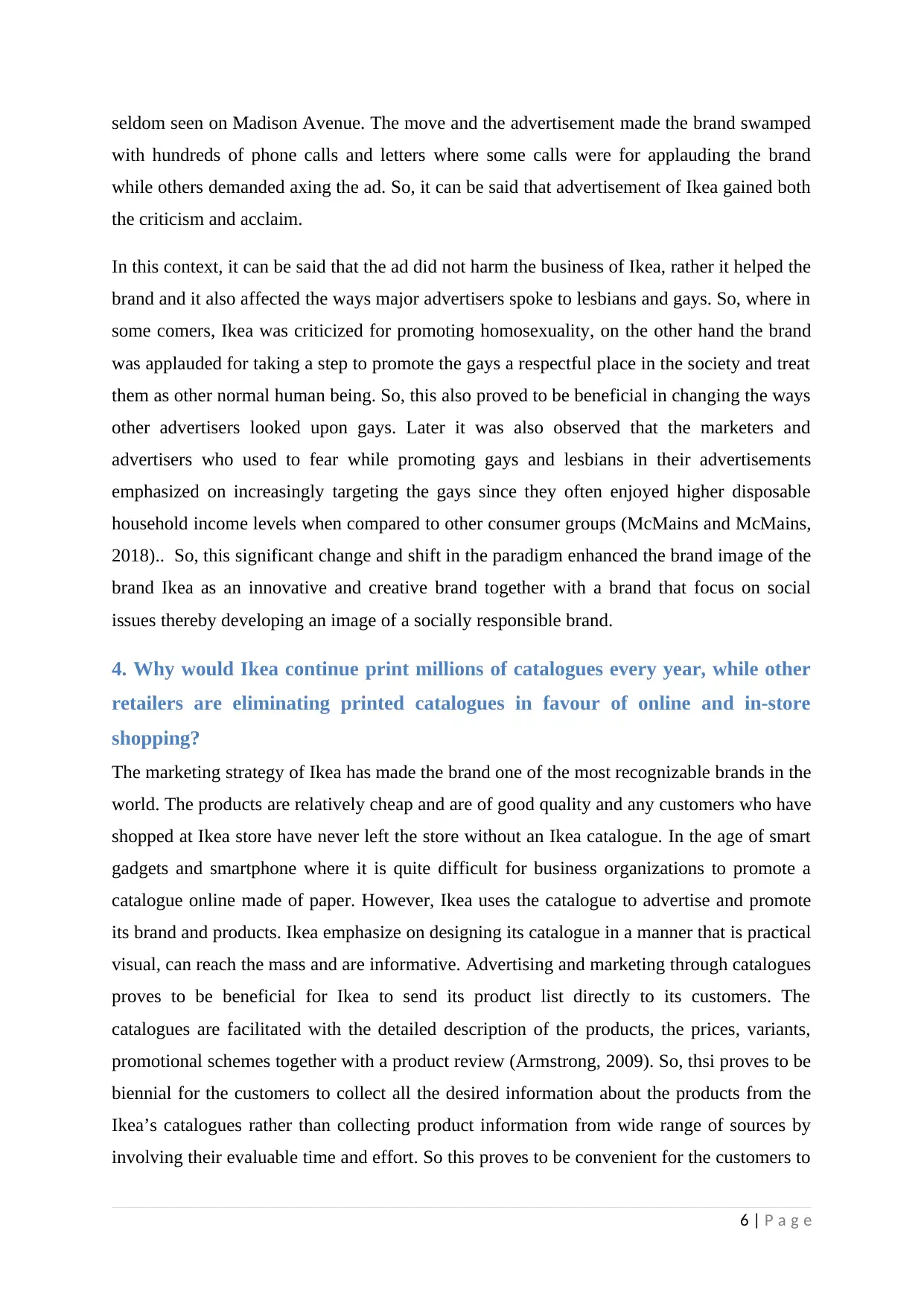
seldom seen on Madison Avenue. The move and the advertisement made the brand swamped
with hundreds of phone calls and letters where some calls were for applauding the brand
while others demanded axing the ad. So, it can be said that advertisement of Ikea gained both
the criticism and acclaim.
In this context, it can be said that the ad did not harm the business of Ikea, rather it helped the
brand and it also affected the ways major advertisers spoke to lesbians and gays. So, where in
some comers, Ikea was criticized for promoting homosexuality, on the other hand the brand
was applauded for taking a step to promote the gays a respectful place in the society and treat
them as other normal human being. So, this also proved to be beneficial in changing the ways
other advertisers looked upon gays. Later it was also observed that the marketers and
advertisers who used to fear while promoting gays and lesbians in their advertisements
emphasized on increasingly targeting the gays since they often enjoyed higher disposable
household income levels when compared to other consumer groups (McMains and McMains,
2018).. So, this significant change and shift in the paradigm enhanced the brand image of the
brand Ikea as an innovative and creative brand together with a brand that focus on social
issues thereby developing an image of a socially responsible brand.
4. Why would Ikea continue print millions of catalogues every year, while other
retailers are eliminating printed catalogues in favour of online and in-store
shopping?
The marketing strategy of Ikea has made the brand one of the most recognizable brands in the
world. The products are relatively cheap and are of good quality and any customers who have
shopped at Ikea store have never left the store without an Ikea catalogue. In the age of smart
gadgets and smartphone where it is quite difficult for business organizations to promote a
catalogue online made of paper. However, Ikea uses the catalogue to advertise and promote
its brand and products. Ikea emphasize on designing its catalogue in a manner that is practical
visual, can reach the mass and are informative. Advertising and marketing through catalogues
proves to be beneficial for Ikea to send its product list directly to its customers. The
catalogues are facilitated with the detailed description of the products, the prices, variants,
promotional schemes together with a product review (Armstrong, 2009). So, thsi proves to be
biennial for the customers to collect all the desired information about the products from the
Ikea’s catalogues rather than collecting product information from wide range of sources by
involving their evaluable time and effort. So this proves to be convenient for the customers to
6 | P a g e
with hundreds of phone calls and letters where some calls were for applauding the brand
while others demanded axing the ad. So, it can be said that advertisement of Ikea gained both
the criticism and acclaim.
In this context, it can be said that the ad did not harm the business of Ikea, rather it helped the
brand and it also affected the ways major advertisers spoke to lesbians and gays. So, where in
some comers, Ikea was criticized for promoting homosexuality, on the other hand the brand
was applauded for taking a step to promote the gays a respectful place in the society and treat
them as other normal human being. So, this also proved to be beneficial in changing the ways
other advertisers looked upon gays. Later it was also observed that the marketers and
advertisers who used to fear while promoting gays and lesbians in their advertisements
emphasized on increasingly targeting the gays since they often enjoyed higher disposable
household income levels when compared to other consumer groups (McMains and McMains,
2018).. So, this significant change and shift in the paradigm enhanced the brand image of the
brand Ikea as an innovative and creative brand together with a brand that focus on social
issues thereby developing an image of a socially responsible brand.
4. Why would Ikea continue print millions of catalogues every year, while other
retailers are eliminating printed catalogues in favour of online and in-store
shopping?
The marketing strategy of Ikea has made the brand one of the most recognizable brands in the
world. The products are relatively cheap and are of good quality and any customers who have
shopped at Ikea store have never left the store without an Ikea catalogue. In the age of smart
gadgets and smartphone where it is quite difficult for business organizations to promote a
catalogue online made of paper. However, Ikea uses the catalogue to advertise and promote
its brand and products. Ikea emphasize on designing its catalogue in a manner that is practical
visual, can reach the mass and are informative. Advertising and marketing through catalogues
proves to be beneficial for Ikea to send its product list directly to its customers. The
catalogues are facilitated with the detailed description of the products, the prices, variants,
promotional schemes together with a product review (Armstrong, 2009). So, thsi proves to be
biennial for the customers to collect all the desired information about the products from the
Ikea’s catalogues rather than collecting product information from wide range of sources by
involving their evaluable time and effort. So this proves to be convenient for the customers to
6 | P a g e
Paraphrase This Document
Need a fresh take? Get an instant paraphrase of this document with our AI Paraphraser
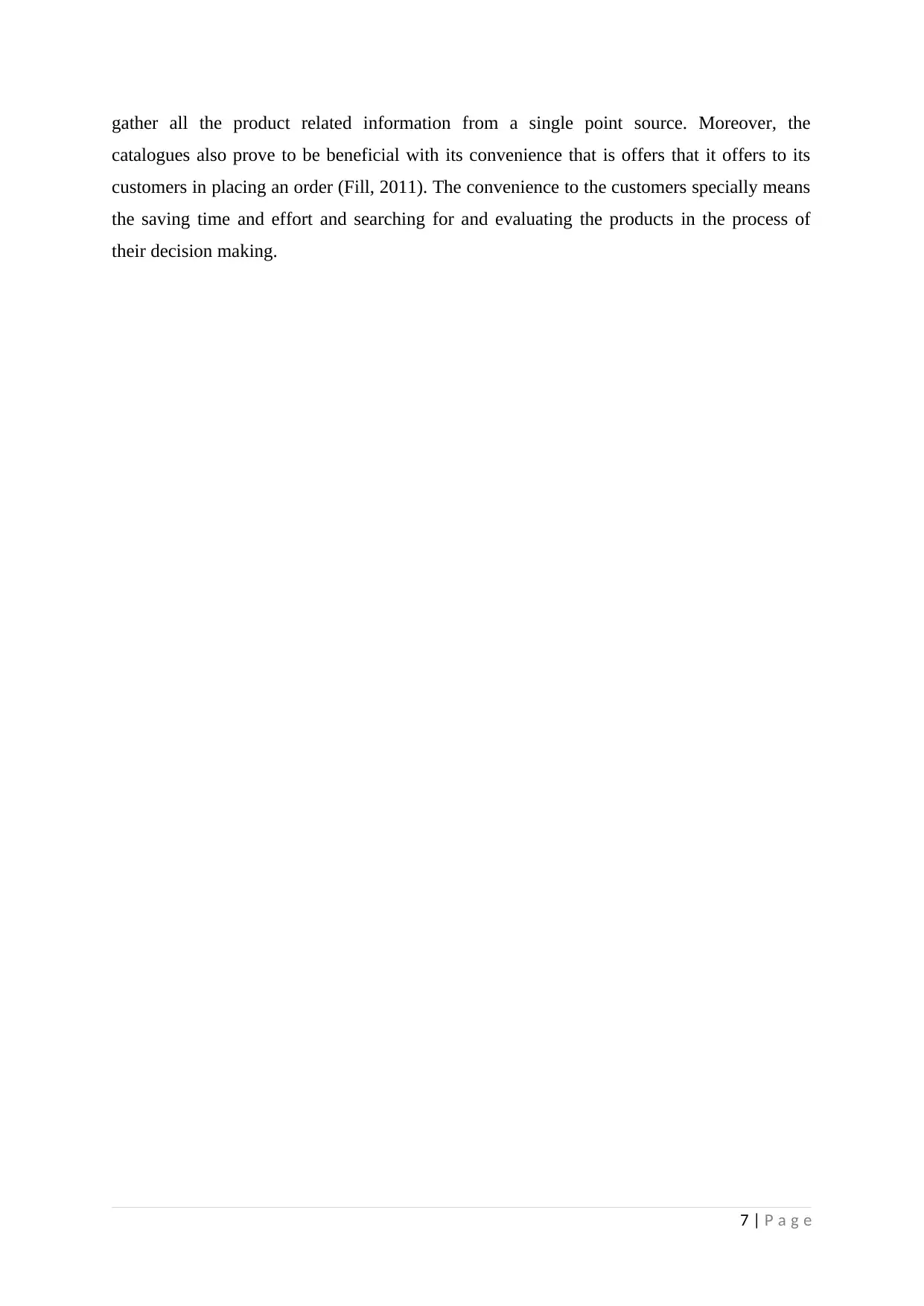
gather all the product related information from a single point source. Moreover, the
catalogues also prove to be beneficial with its convenience that is offers that it offers to its
customers in placing an order (Fill, 2011). The convenience to the customers specially means
the saving time and effort and searching for and evaluating the products in the process of
their decision making.
7 | P a g e
catalogues also prove to be beneficial with its convenience that is offers that it offers to its
customers in placing an order (Fill, 2011). The convenience to the customers specially means
the saving time and effort and searching for and evaluating the products in the process of
their decision making.
7 | P a g e
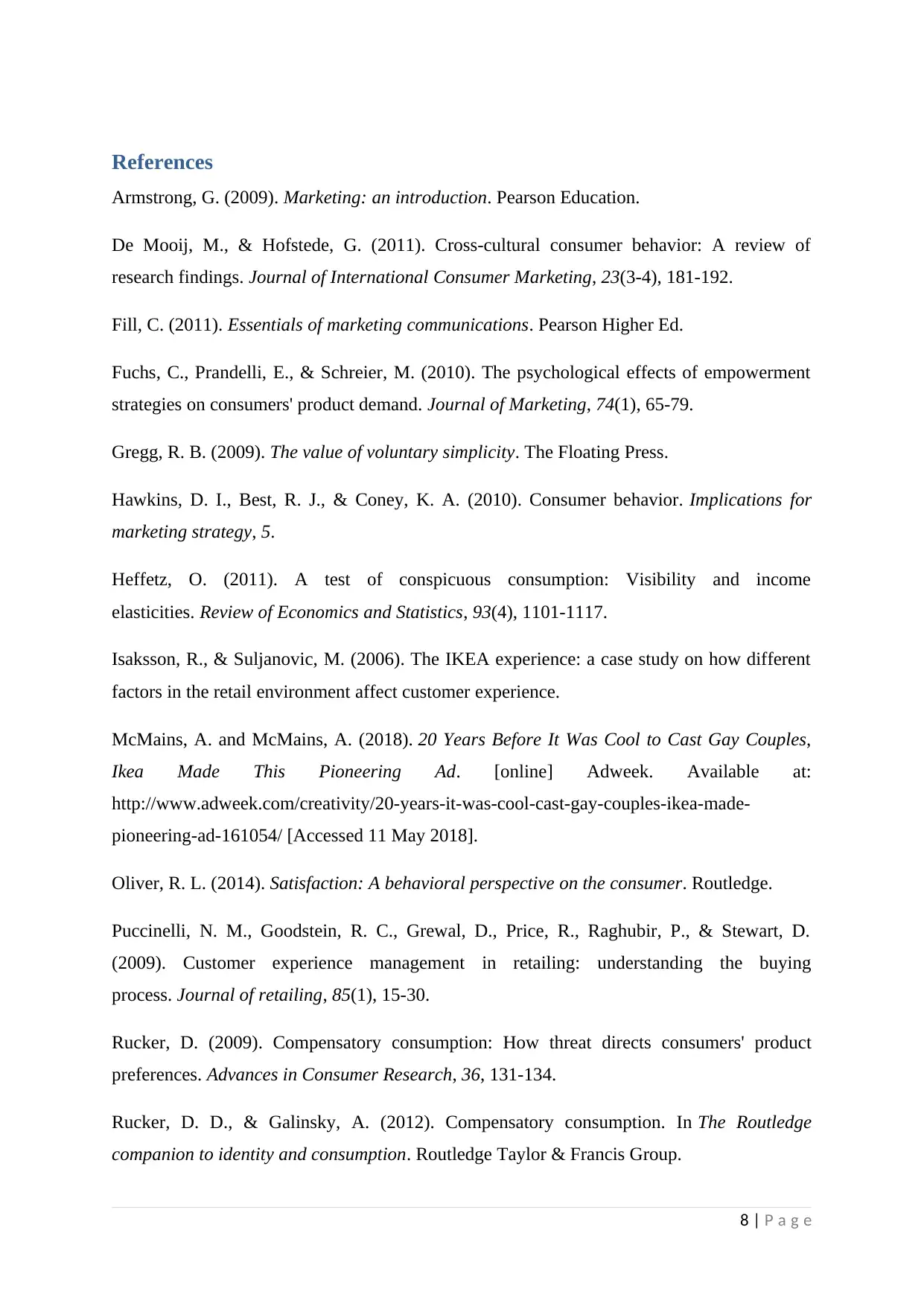
References
Armstrong, G. (2009). Marketing: an introduction. Pearson Education.
De Mooij, M., & Hofstede, G. (2011). Cross-cultural consumer behavior: A review of
research findings. Journal of International Consumer Marketing, 23(3-4), 181-192.
Fill, C. (2011). Essentials of marketing communications. Pearson Higher Ed.
Fuchs, C., Prandelli, E., & Schreier, M. (2010). The psychological effects of empowerment
strategies on consumers' product demand. Journal of Marketing, 74(1), 65-79.
Gregg, R. B. (2009). The value of voluntary simplicity. The Floating Press.
Hawkins, D. I., Best, R. J., & Coney, K. A. (2010). Consumer behavior. Implications for
marketing strategy, 5.
Heffetz, O. (2011). A test of conspicuous consumption: Visibility and income
elasticities. Review of Economics and Statistics, 93(4), 1101-1117.
Isaksson, R., & Suljanovic, M. (2006). The IKEA experience: a case study on how different
factors in the retail environment affect customer experience.
McMains, A. and McMains, A. (2018). 20 Years Before It Was Cool to Cast Gay Couples,
Ikea Made This Pioneering Ad. [online] Adweek. Available at:
http://www.adweek.com/creativity/20-years-it-was-cool-cast-gay-couples-ikea-made-
pioneering-ad-161054/ [Accessed 11 May 2018].
Oliver, R. L. (2014). Satisfaction: A behavioral perspective on the consumer. Routledge.
Puccinelli, N. M., Goodstein, R. C., Grewal, D., Price, R., Raghubir, P., & Stewart, D.
(2009). Customer experience management in retailing: understanding the buying
process. Journal of retailing, 85(1), 15-30.
Rucker, D. (2009). Compensatory consumption: How threat directs consumers' product
preferences. Advances in Consumer Research, 36, 131-134.
Rucker, D. D., & Galinsky, A. (2012). Compensatory consumption. In The Routledge
companion to identity and consumption. Routledge Taylor & Francis Group.
8 | P a g e
Armstrong, G. (2009). Marketing: an introduction. Pearson Education.
De Mooij, M., & Hofstede, G. (2011). Cross-cultural consumer behavior: A review of
research findings. Journal of International Consumer Marketing, 23(3-4), 181-192.
Fill, C. (2011). Essentials of marketing communications. Pearson Higher Ed.
Fuchs, C., Prandelli, E., & Schreier, M. (2010). The psychological effects of empowerment
strategies on consumers' product demand. Journal of Marketing, 74(1), 65-79.
Gregg, R. B. (2009). The value of voluntary simplicity. The Floating Press.
Hawkins, D. I., Best, R. J., & Coney, K. A. (2010). Consumer behavior. Implications for
marketing strategy, 5.
Heffetz, O. (2011). A test of conspicuous consumption: Visibility and income
elasticities. Review of Economics and Statistics, 93(4), 1101-1117.
Isaksson, R., & Suljanovic, M. (2006). The IKEA experience: a case study on how different
factors in the retail environment affect customer experience.
McMains, A. and McMains, A. (2018). 20 Years Before It Was Cool to Cast Gay Couples,
Ikea Made This Pioneering Ad. [online] Adweek. Available at:
http://www.adweek.com/creativity/20-years-it-was-cool-cast-gay-couples-ikea-made-
pioneering-ad-161054/ [Accessed 11 May 2018].
Oliver, R. L. (2014). Satisfaction: A behavioral perspective on the consumer. Routledge.
Puccinelli, N. M., Goodstein, R. C., Grewal, D., Price, R., Raghubir, P., & Stewart, D.
(2009). Customer experience management in retailing: understanding the buying
process. Journal of retailing, 85(1), 15-30.
Rucker, D. (2009). Compensatory consumption: How threat directs consumers' product
preferences. Advances in Consumer Research, 36, 131-134.
Rucker, D. D., & Galinsky, A. (2012). Compensatory consumption. In The Routledge
companion to identity and consumption. Routledge Taylor & Francis Group.
8 | P a g e
⊘ This is a preview!⊘
Do you want full access?
Subscribe today to unlock all pages.

Trusted by 1+ million students worldwide
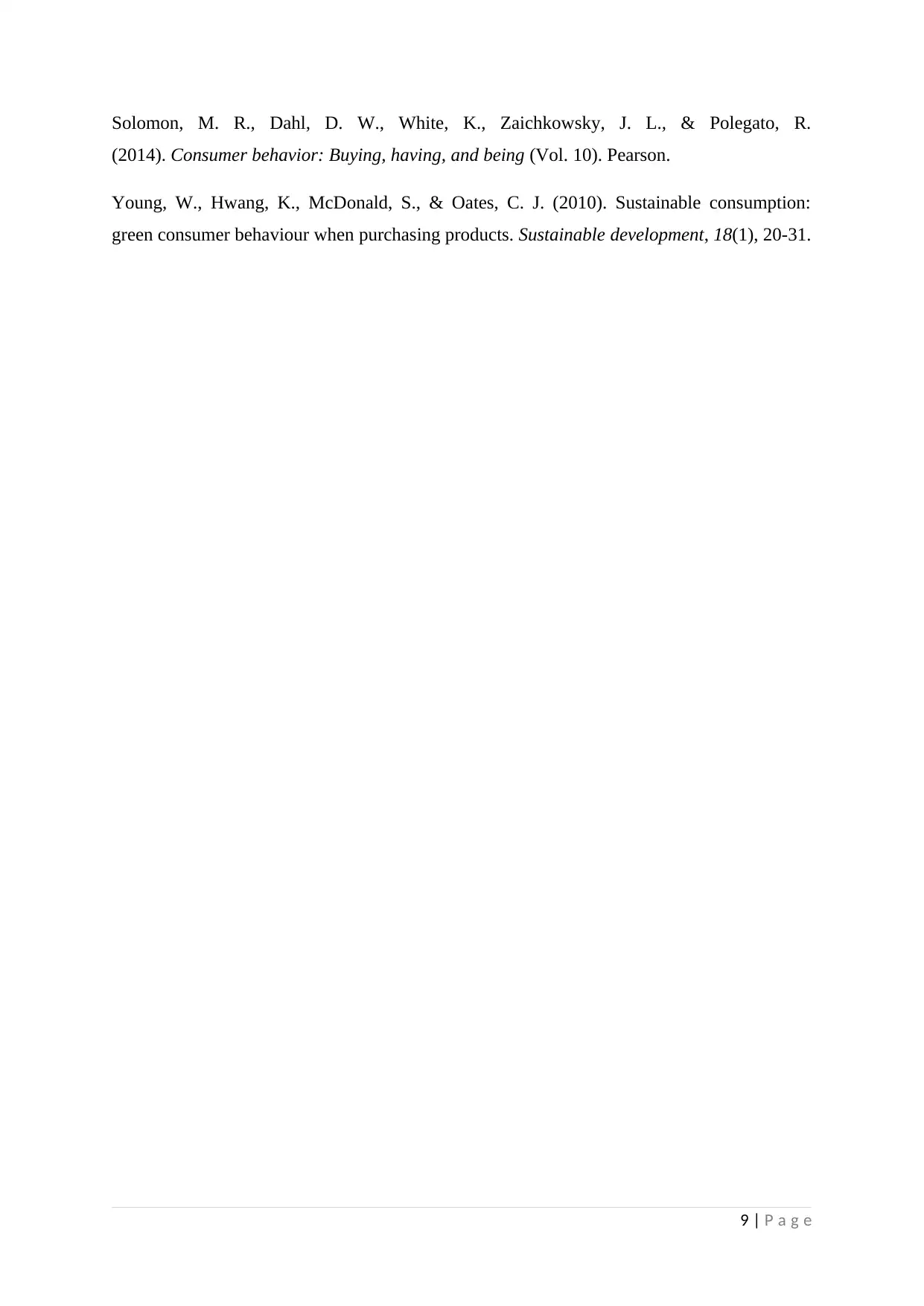
Solomon, M. R., Dahl, D. W., White, K., Zaichkowsky, J. L., & Polegato, R.
(2014). Consumer behavior: Buying, having, and being (Vol. 10). Pearson.
Young, W., Hwang, K., McDonald, S., & Oates, C. J. (2010). Sustainable consumption:
green consumer behaviour when purchasing products. Sustainable development, 18(1), 20-31.
9 | P a g e
(2014). Consumer behavior: Buying, having, and being (Vol. 10). Pearson.
Young, W., Hwang, K., McDonald, S., & Oates, C. J. (2010). Sustainable consumption:
green consumer behaviour when purchasing products. Sustainable development, 18(1), 20-31.
9 | P a g e
1 out of 10
Related Documents
Your All-in-One AI-Powered Toolkit for Academic Success.
+13062052269
info@desklib.com
Available 24*7 on WhatsApp / Email
![[object Object]](/_next/static/media/star-bottom.7253800d.svg)
Unlock your academic potential
Copyright © 2020–2025 A2Z Services. All Rights Reserved. Developed and managed by ZUCOL.





